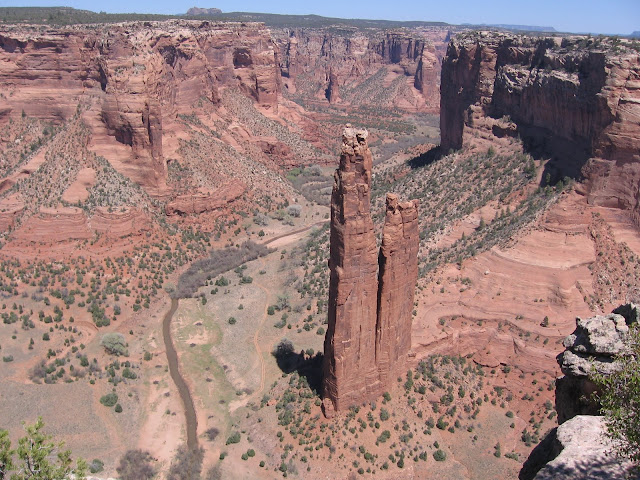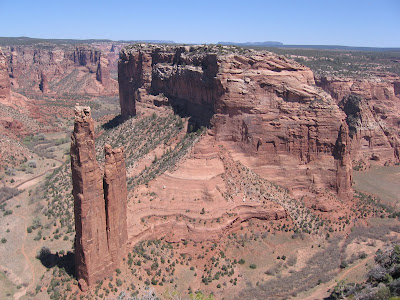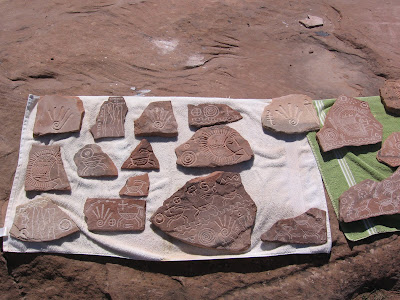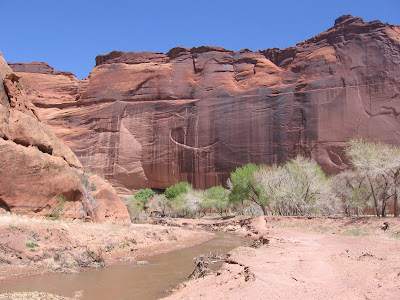There was some reconstruction at the Four Corners Monument during the summer of 2010.
Trails in and near the Navajo Indian Reservation in the Four Corners area of Arizona and New Mexico. Inlcudes Canyon de Chelly, Petrified Forest, Monument Valley, Bandelier, El Malpais, Chaco Canyon, and more. Trail notes and pictures.
Sunday, April 27, 2008
Four Corners Monument
The Four Corners Monument marks the only place where you can stand in four states at the same time. It is operated as a Navajo Tribal Park and is a remote site, a little south of the San Juan River along US Route 160. The main attraction is to stand on the plate, or better yet get down in the push up position so you have a limb in each state.
The main attraction is to stand on the plate, or better yet get down in the push up position so you have a limb in each state.
 The monument is nicely constructed, with a platform providing some elevation for picture taking. There is some interpretive information giving the history of the surveys in the area.
The monument is nicely constructed, with a platform providing some elevation for picture taking. There is some interpretive information giving the history of the surveys in the area.
 Surrounding the monument is an array of flagpoles, with every political entity represented. The surrounding terrain appears to be clay hills and some eroding rock with very little vegetation.
Surrounding the monument is an array of flagpoles, with every political entity represented. The surrounding terrain appears to be clay hills and some eroding rock with very little vegetation.
 The other highlight is the Navajo Market. There are numerous booths and stands for the vendors to sell artwork, food, and souvenirs. Have a Navajo Taco, very tasty.
The other highlight is the Navajo Market. There are numerous booths and stands for the vendors to sell artwork, food, and souvenirs. Have a Navajo Taco, very tasty.
There was some reconstruction at the Four Corners Monument during the summer of 2010.
There was some reconstruction at the Four Corners Monument during the summer of 2010.
Friday, April 25, 2008
White House Ruins Trail
The White House Ruins Trail at Canyon de Chelly National Monument in NE Arizona is about a 3 mile round trip with a 600 foot vertical descent. It is located along the south rim road.
 The hike begins at the White House Ruins overlook. There is a short walk along the rim before the trail begins to descend. This is the only trail in Canyon de Chelly that allows hiking into the inner canyon without a guide.
The hike begins at the White House Ruins overlook. There is a short walk along the rim before the trail begins to descend. This is the only trail in Canyon de Chelly that allows hiking into the inner canyon without a guide.
 The trail winds down the side of the cliff through high desert vegetation. There are several benches along the way giving views down towards the canyon bottom.
The trail winds down the side of the cliff through high desert vegetation. There are several benches along the way giving views down towards the canyon bottom.
There is a small alcove in the upper part of the trail that probably counts as an arch.
 A short sandy walk along the canyon bottom approaches the ruin site and there are foot bridges across the wash. Current Navajos have some dwellings and fields in this section of the canyon for summer use. A fence guards White House Ruins from close approach, so all the pictures of it are from the same distance with no close up details.
A short sandy walk along the canyon bottom approaches the ruin site and there are foot bridges across the wash. Current Navajos have some dwellings and fields in this section of the canyon for summer use. A fence guards White House Ruins from close approach, so all the pictures of it are from the same distance with no close up details.
During most of the year, even winter, Navajo vendors will have tables set up near the ruins site for selling art work. The canyon driving tours will bring groups of visitors in addition to hikers coming down the trail.
 The White House Ruin has a two level structure. It is named for the long wall in the center of the upper dwelling that is covered with white plaster. There are some pictographs on the canyon walls above and to the left of the structures to look for. The White House in the upper level middle has some historic inscriptions that can be seen with binoculars.
The White House Ruin has a two level structure. It is named for the long wall in the center of the upper dwelling that is covered with white plaster. There are some pictographs on the canyon walls above and to the left of the structures to look for. The White House in the upper level middle has some historic inscriptions that can be seen with binoculars.
It took me about 1:30 to walk the trail down and up, including lingering at the bottom. (There is a separate post showing some of the rock art on the walls here. Click on the label for White House Ruins Trail.)


There is a small alcove in the upper part of the trail that probably counts as an arch.
During most of the year, even winter, Navajo vendors will have tables set up near the ruins site for selling art work. The canyon driving tours will bring groups of visitors in addition to hikers coming down the trail.
It took me about 1:30 to walk the trail down and up, including lingering at the bottom. (There is a separate post showing some of the rock art on the walls here. Click on the label for White House Ruins Trail.)
Thursday, April 24, 2008
Spider Rock and Sliding House Overlooks at Canyon de Chelly
One of the best known features visible from the rim overlooks in Canyon de Chelly in NE Arizona is Spider Rock, an 800 foot spire that is sometimes described as the home of Spider woman, a character from Navajo mythology.
 One story has it that she is the one who gave the gift of weaving to the Navajos. Navajo weaving has become an art form. This is practiced mostly by women and there are many traditional and modern designs.
One story has it that she is the one who gave the gift of weaving to the Navajos. Navajo weaving has become an art form. This is practiced mostly by women and there are many traditional and modern designs.
When I first started looking at these I was shocked at how expensive they were, costing hundreds and sometimes thousands of dollars.
 The Spider Rock is at the junction of Canyon de Chelly and Monument Canyon to the right. The Chuska Mountains are visible on the horizon.
The Spider Rock is at the junction of Canyon de Chelly and Monument Canyon to the right. The Chuska Mountains are visible on the horizon.
The massive cliffs that form the walls of the canyon are De Chelly Sandstone. The De Chelly Sandstone was deposited as dunes in an arid environment about 250 to 230 million years ago. The caprock along the canyon is known as the Shinarump Conglomerate, a layer of stream deposited sand and gravel.
 The next turn off down from Spider Rock is Sliding House, named for its precarious location on a steep slope. The sandstone cliffs here have the dark manganese deposits usually called desert varnish, and they also seem to have some white deposits, perhaps a seep spring that has evaporated.
The next turn off down from Spider Rock is Sliding House, named for its precarious location on a steep slope. The sandstone cliffs here have the dark manganese deposits usually called desert varnish, and they also seem to have some white deposits, perhaps a seep spring that has evaporated.
 The desert varnish was often scratched to make petroglyphs. Current Navajo artists are starting to sell petroglyph designs scratched into pieces of sandstone. There are Navajo vendors everywhere you might stop in Canyon de Chelly.
The desert varnish was often scratched to make petroglyphs. Current Navajo artists are starting to sell petroglyph designs scratched into pieces of sandstone. There are Navajo vendors everywhere you might stop in Canyon de Chelly.
I bought the one in the upper left of the green towell for $20. The artist claims that the designs are copies of actual petroglyphs found in various places in the canyon.
When I first started looking at these I was shocked at how expensive they were, costing hundreds and sometimes thousands of dollars.
The massive cliffs that form the walls of the canyon are De Chelly Sandstone. The De Chelly Sandstone was deposited as dunes in an arid environment about 250 to 230 million years ago. The caprock along the canyon is known as the Shinarump Conglomerate, a layer of stream deposited sand and gravel.
I bought the one in the upper left of the green towell for $20. The artist claims that the designs are copies of actual petroglyphs found in various places in the canyon.
Labels:
Canyon de Chelly,
Sliding House,
Spider Rock
Inner Canyon Tour at Canyon de Chelly
Canyon de Chelly National Monument is entirely inside the Navajo Indian Reservation in NE Arizona. Besides being a spectacular natural feature with 700 foot sheer sandstone walls, it has two cultural overlays.
It is the traditional center of Navajo territory since their arrival in the area 500 years ago, and it has ruins of the collapsed Anasazi pueblo culture that moved out 700 years ago.

The rim drives are open at all times but the inner canyon is restricted. A good way to see visit the rest of the canyon bottom is to take one of the 4 wheel drive tours. The tour I took started at the Thunderbird Lodge and entered at the canyon mouth. The tour lasted nearly four hours and started up the north arm, called Canyon del Muerto continueing to just past the Antelope House ruin.
 There were about 20 on the tour in a big 4 x 4 truck outfitted with padded seats. The driver was a Navajo whose family had a camp in north arm and who had been giving tours for 27 years.
There were about 20 on the tour in a big 4 x 4 truck outfitted with padded seats. The driver was a Navajo whose family had a camp in north arm and who had been giving tours for 27 years.
 The Antelope House Ruin is visible from above at one of the overlooks along the north rim. Navajo Fortress is visible from the same area.
The Antelope House Ruin is visible from above at one of the overlooks along the north rim. Navajo Fortress is visible from the same area.
 Along the way. besides the ruins and the lush scenery at the canyon bottom, we passed the summer activities of Navajo families, some farming and herding, and children playing in the water.
Along the way. besides the ruins and the lush scenery at the canyon bottom, we passed the summer activities of Navajo families, some farming and herding, and children playing in the water.
The massive cliffs that form the walls of the canyon are De Chelly Sandstone. The De Chelly Sandstone was deposited as dunes in an arid environment about 250 to 230 million years ago. The caprock along the canyon is known as the Shinarump Conglomerate, a layer of stream deposited sand and gravel.
 We turned around and went back down Canyon Del Muerto and up the Canyon de Chelly arm to the White House ruins. This ruin can be visited by trail also.
We turned around and went back down Canyon Del Muerto and up the Canyon de Chelly arm to the White House ruins. This ruin can be visited by trail also.
There is a lot of rock art along the way in lower parts of the Canyon de Chelly. The tours may go past these sites quickly, or the views may just be from the vehicle. Near the Canyon mouth is Kokopelli Cave. On the left side of the cave are pictographs of handprints and a reclining flute player.
There is also a site near the canyon mouth called Newspaper Rock and Triangle Man just across from it. Newspaper Rock has many images but they are hard to see without binoculars. Whether the tour stops at these sites might depend on the guide.
A short distance before the Antelope House is a site called Black Bull Cave. Here there are some broad shouldered painted figures and hand prints. The yellow image is a flute player but is hard to see.
(I later took a tour in a jeep and saw some more of the details in this area, particularly the small ruins sites. Use the label "Canyon de Chelly Tours".)

It is the traditional center of Navajo territory since their arrival in the area 500 years ago, and it has ruins of the collapsed Anasazi pueblo culture that moved out 700 years ago.
The rim drives are open at all times but the inner canyon is restricted. A good way to see visit the rest of the canyon bottom is to take one of the 4 wheel drive tours. The tour I took started at the Thunderbird Lodge and entered at the canyon mouth. The tour lasted nearly four hours and started up the north arm, called Canyon del Muerto continueing to just past the Antelope House ruin.
The massive cliffs that form the walls of the canyon are De Chelly Sandstone. The De Chelly Sandstone was deposited as dunes in an arid environment about 250 to 230 million years ago. The caprock along the canyon is known as the Shinarump Conglomerate, a layer of stream deposited sand and gravel.
There is a lot of rock art along the way in lower parts of the Canyon de Chelly. The tours may go past these sites quickly, or the views may just be from the vehicle. Near the Canyon mouth is Kokopelli Cave. On the left side of the cave are pictographs of handprints and a reclining flute player.
There is also a site near the canyon mouth called Newspaper Rock and Triangle Man just across from it. Newspaper Rock has many images but they are hard to see without binoculars. Whether the tour stops at these sites might depend on the guide.
A short distance before the Antelope House is a site called Black Bull Cave. Here there are some broad shouldered painted figures and hand prints. The yellow image is a flute player but is hard to see.
(I later took a tour in a jeep and saw some more of the details in this area, particularly the small ruins sites. Use the label "Canyon de Chelly Tours".)
Wednesday, April 23, 2008
Antelope House Overlook at Canyon de Chelly
The Antelope House Overlook is on the north rim of Canyon de Chelly, and overlooks the Del Muerto arm of the canyon system. From the parking lot it is a 0.25 mile walk to the several overlooks over mostly a sandstone trail.
 The Antelope House name is from some antelope drawings made by a Navajo artist in the early 1800s. The inner canyon tours stop at Antelope House and some arts and crafts are usually on sale there. It is thought that construction at this site began around 700 AD and continued for 600 years, on and off. Gazing out across the canyon, there are views of the shear sandstone walls and the stream that runs along the bottom.
The Antelope House name is from some antelope drawings made by a Navajo artist in the early 1800s. The inner canyon tours stop at Antelope House and some arts and crafts are usually on sale there. It is thought that construction at this site began around 700 AD and continued for 600 years, on and off. Gazing out across the canyon, there are views of the shear sandstone walls and the stream that runs along the bottom.
 From the other viewpoint is the formation called the Navajo Fortress. This site is at the junction of Del Muerto and Black Rock Canyons and was used as a refuge from enemies until the 1860s. It is thought the Navajo had a system of ladders to allow them to reach and otherwise difficult location.
From the other viewpoint is the formation called the Navajo Fortress. This site is at the junction of Del Muerto and Black Rock Canyons and was used as a refuge from enemies until the 1860s. It is thought the Navajo had a system of ladders to allow them to reach and otherwise difficult location.
Mummy Cave Ruin Overlook at Canyon de Chelly
Canyon de Chelly National Monument is in northeast Arizona in the center of the Navajo Indian Reservation near Chinle. Along the north rim of the canyon are several short walks to spectacular overlooks.
 The sandstone cliffs in Canyon de Chelly are 600 feet high. The Mummy Cave Ruin way down below is one of the largest pueblo villages in the canyon and was occupied until about 1300.
The sandstone cliffs in Canyon de Chelly are 600 feet high. The Mummy Cave Ruin way down below is one of the largest pueblo villages in the canyon and was occupied until about 1300.
The building style suggests that people from the Mesa Verde area migrated here. The alcove gets better direct sunlight in the winter.
 The Navajo name for this site is House Under the Rock. At the canyon bottom a small stream wanders between the steep cliffs and past the small farm fields of the Navajo who live here now.
The Navajo name for this site is House Under the Rock. At the canyon bottom a small stream wanders between the steep cliffs and past the small farm fields of the Navajo who live here now.
 To the North of the Mummy Cave overlook is the Massacre Cave overlook. In 1805 a Spanish military expedition fired on Navajos hiding in the alcove from this site. The Navajo name for the site is The place where two fell off.
To the North of the Mummy Cave overlook is the Massacre Cave overlook. In 1805 a Spanish military expedition fired on Navajos hiding in the alcove from this site. The Navajo name for the site is The place where two fell off.
 On the other side at the same site, a small ruin, Yucca Cave, is visible in an alcove perched high on the canyon wall.
On the other side at the same site, a small ruin, Yucca Cave, is visible in an alcove perched high on the canyon wall.
The building style suggests that people from the Mesa Verde area migrated here. The alcove gets better direct sunlight in the winter.
Labels:
Canyon de Chelly,
Massacre Cave,
Mummy Cave
Subscribe to:
Posts (Atom)